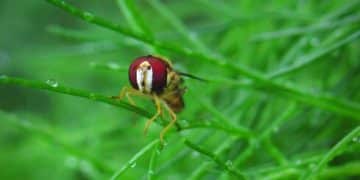Natural Flea and Tick Remedies: Safe Alternatives for Your Pet

Natural remedies for flea and tick control offer safe and effective alternatives to harsh chemical treatments, utilizing ingredients like essential oils and herbal solutions to protect your pets from pests.
Protecting your furry friends from fleas and ticks doesn’t have to involve harsh chemicals. Natural remedies for flea and tick control: safe and effective alternatives are available to help keep your pets comfortable and pest-free using ingredients you can trust. Discover how to create a healthier environment for your beloved companions.
Understanding the Flea and Tick Problem
Fleas and ticks are more than just a nuisance; they can pose significant health risks to your pets. Understanding the severity of infestations and how these parasites thrive is crucial for effective prevention and treatment.
Fleas can cause intense itching, allergic reactions, and even transmit diseases like tapeworms. Ticks, on the other hand, are notorious for carrying Lyme disease, ehrlichiosis, and Rocky Mountain spotted fever, among other harmful pathogens. Knowing the risks helps you prioritize your pet’s health and well-being.
The Life Cycle of Fleas and Ticks
Understanding the life cycle of these pests can aid in targeted treatment strategies. Fleas go through four stages: egg, larva, pupa, and adult. Ticks also have multiple stages, including larva, nymph, and adult, each requiring a blood meal to progress.
Identifying Flea and Tick Habitats
Knowing where fleas and ticks thrive can help you focus your control efforts. Fleas prefer warm, humid environments and can be found in carpets, upholstery, and pet bedding. Ticks often live in grassy, wooded areas, waiting to attach to a passing host.
- 🏠 Regularly vacuum carpets and upholstery
- 🧺 Wash pet bedding frequently in hot water
- 🌿 Keep your yard well-maintained and free of debris
By understanding the flea and tick problem, you can take proactive steps to protect your pets using safe, natural remedies.

Essential Oils for Flea and Tick Prevention
Essential oils have gained popularity as a natural way to repel fleas and ticks. Certain oils possess properties that make them effective, but it’s crucial to use them safely and correctly to avoid harming your pets.
Many pet owners are turning to essential oils as a gentler alternative to chemical-laden products. These oils not only repel pests but also offer additional benefits, such as soothing skin irritations and promoting relaxation. However, it’s vital to understand which oils are safe and how to dilute them properly.
Safe Essential Oils for Pets
Some essential oils are safer than others for use on pets. Lavender, cedarwood, and peppermint oils are often recommended for their repellent properties and relatively low toxicity when properly diluted.
How to Dilute and Apply Essential Oils
Dilution is key when using essential oils on pets. A general guideline is to mix 1-3 drops of essential oil with a carrier oil, such as coconut or almond oil, at a concentration of 0.5-1%. Apply the diluted mixture to areas like the back of the neck or base of the tail, where your pet cannot easily lick it off.
- 💧 Always dilute essential oils with a carrier oil
- ⚠️ Avoid using essential oils on cats without veterinary guidance
- 👂 Test a small area first to check for allergic reactions
The responsible use of essential oils can be an effective part of your flea and tick prevention strategy, promoting your pet’s health without the risks associated with harsh chemicals.
Herbal Remedies for Flea and Tick Control
Harnessing the power of herbs offers another natural avenue for controlling fleas and ticks. These herbal remedies are often gentler than chemical treatments and can be incorporated into your pet’s daily routine.
Herbal remedies have been used for centuries to manage pests. They provide a holistic approach to pet care, addressing not only the immediate problem but also contributing to overall health and well-being. By using herbs, you can create a natural barrier against fleas and ticks.
Neem Oil
Neem oil is derived from the neem tree and contains insecticidal properties. It can disrupt the life cycle of fleas and ticks, preventing them from reproducing. Dilute neem oil with a carrier oil and apply it to your pet’s coat.
Diatomaceous Earth (DE)
Diatomaceous earth is a natural powder made from fossilized algae. It works by dehydrating fleas and ticks on contact. Use food-grade DE and sprinkle it lightly in areas where your pet spends time, such as carpets and bedding.
Herbal Flea Collars
You can create your own herbal flea collar by adding a few drops of safe essential oils to a plain collar. Reapply the oils every few days to maintain the repellent effect.
- 🌿 Mix neem oil with a carrier oil for topical application
- 🐾 Sprinkle food-grade diatomaceous earth in pet areas
- 🎽 Refresh herbal flea collars with essential oils regularly
Integrating herbal remedies into your pet care routine offers a safer and more natural way to keep fleas and ticks at bay, supporting your pet’s health and environmental consciousness.
Creating a Flea and Tick-Repellent Environment
The environment in and around your home plays a crucial role in flea and tick infestations. By taking steps to make your home and yard less hospitable to these pests, you can significantly reduce the risk to your pets.
A comprehensive approach includes not only treating your pets but also managing their surroundings. Fleas and ticks thrive in specific conditions, and modifying these conditions can naturally deter them. This holistic strategy addresses the root causes of infestations rather than just the symptoms.
Yard Maintenance
Keep your lawn mowed and remove leaf litter and debris where ticks can hide. Trim shrubs and bushes to allow sunlight to penetrate, making it less appealing for pests.
Indoor Cleaning Practices
Regularly vacuum carpets, rugs, and upholstery to remove flea eggs, larvae, and pupae. Wash pet bedding frequently in hot water to kill any remaining pests.
Natural Yard Sprays
Consider using natural yard sprays containing ingredients like cedarwood oil or nematodes, which are beneficial organisms that prey on fleas and ticks.

- 🏡 Maintain a well-groomed yard
- 🧹 Regularly clean indoor spaces
- 🌱 Use natural yard sprays as needed
Creating a pest-repellent environment is a critical part of natural flea and tick control, reducing the likelihood of re-infestation and contributing to a healthier living space for everyone.
Diet and Supplements for Pest Resistance
A strong immune system is your pet’s first line of defense against fleas and ticks. Proper nutrition and targeted supplements can bolster your pet’s natural resistance, making them less attractive to pests.
Similar to humans, a healthy diet can significantly impact a pet’s ability to fend off infections and infestations. Nutrients support the immune system, improve skin health, and reduce inflammation, making it harder for pests to thrive. Supplements can fill nutritional gaps and provide additional support.
Omega-3 Fatty Acids
Omega-3 fatty acids, found in fish oil, promote healthy skin and reduce inflammation, making it harder for fleas and ticks to bite and cause irritation.
Vitamin B Complex
Vitamin B complex supports nerve function and can make your pet’s skin less appealing to fleas. Brewer’s yeast is a natural source of B vitamins that can be added to your pet’s food.
Garlic (Use with Caution)
Some pet owners use small amounts of garlic as a natural flea repellent. However, garlic can be toxic to pets in large quantities, so consult with your veterinarian before adding it to their diet.
- 🐟 Supplement with omega-3 fatty acids
- 💊 Add vitamin B complex to their diet
- 🧄 Use garlic cautiously with vet approval
Incorporating diet and supplements into your pet care routine enhances their natural pest resistance, complementing other natural flea and tick control methods.
When to Seek Veterinary Advice
While natural remedies can be highly effective, it’s essential to recognize when professional veterinary care is necessary. Knowing the signs of a severe infestation or related health issues will ensure your pet receives the appropriate treatment.
Sometimes, despite our best efforts, natural methods may not be enough to fully resolve a flea or tick problem. It’s crucial to monitor your pet closely and consult a vet if symptoms persist or worsen. Early intervention can prevent more severe health complications.
Signs of Flea and Tick Infestation
Look for excessive scratching, biting, or licking, hair loss, and visible fleas or ticks on your pet’s skin. Red, irritated skin and flea dirt (flea feces) are also common signs.
Symptoms of Tick-Borne Diseases
Be aware of symptoms like fever, lethargy, lameness, joint pain, and loss of appetite. These could indicate a tick-borne disease that requires prompt veterinary attention.
When Natural Remedies Aren’t Enough
If you’ve tried natural remedies for several weeks without significant improvement, or if your pet’s condition worsens, consult your veterinarian. They can provide additional diagnostic tests and treatment options.
- 🔍 Monitor for signs of infestation: scratching, hair loss
- 🌡️ Watch for symptoms of tick-borne diseases: fever, lameness
- 🩺 Seek vet advice if natural remedies fail
Knowing when to seek professional veterinary advice ensures your pet receives the comprehensive care they need, balancing natural methods with appropriate medical interventions.
| Key Point | Brief Description |
|---|---|
| 🌿 Essential Oils | Use diluted lavender, cedarwood, or peppermint oil. |
| 🐾 Herbal Remedies | Apply neem oil or food-grade diatomaceous earth. |
| 🏡 Environment Control | Maintain a clean yard and vacuum regularly. |
| 🍎 Diet and Supplements | Include omega-3s and B vitamins in your pet’s diet. |
Frequently Asked Questions
▼
Not all essential oils are safe. Cats are particularly sensitive, so consult with a vet before using any essential oils on them. Dilution and proper application are crucial for safety.
▼
Application frequency depends on the specific remedy and your pet’s lifestyle. Generally, reapply every few days or after bathing. Monitor your pet for any adverse reactions.
▼
Yes, but use food-grade diatomaceous earth sparingly. Avoid getting it in your pet’s eyes or respiratory system. It can be drying, so ensure your pet stays hydrated.
▼
Natural remedies may take longer than chemical treatments. Consistency is key. You may start seeing results within a week or two, but full control may take several weeks.
▼
Signs include skin redness, itching, hives, swelling, or difficulty breathing. If you notice any of these symptoms, discontinue use immediately and consult your veterinarian.
Conclusion
Choosing natural remedies for flea and tick control provides a safer, gentler way to protect your pets. By understanding the pests, utilizing essential oils and herbal solutions, and creating a pest-repellent environment, you can maintain your pet’s health and well-being naturally. If concerns arise, always consult with your veterinarian for tailored advice.





